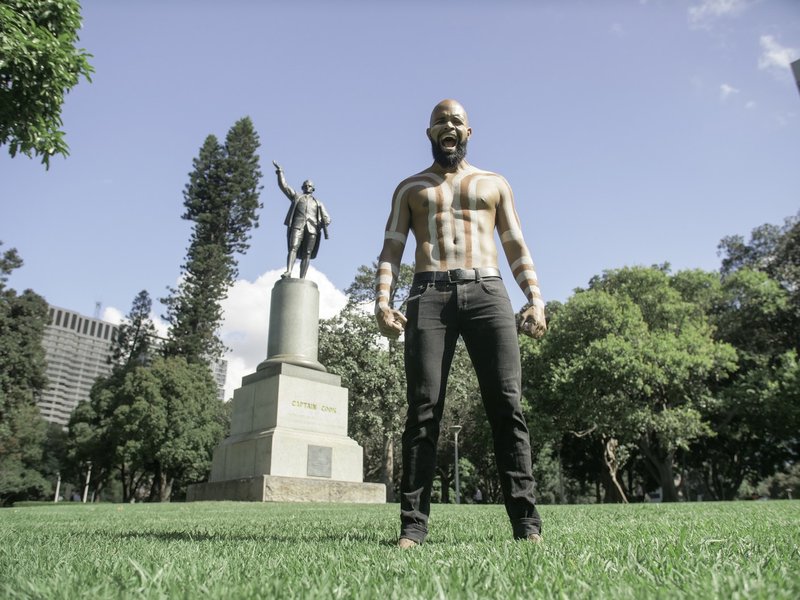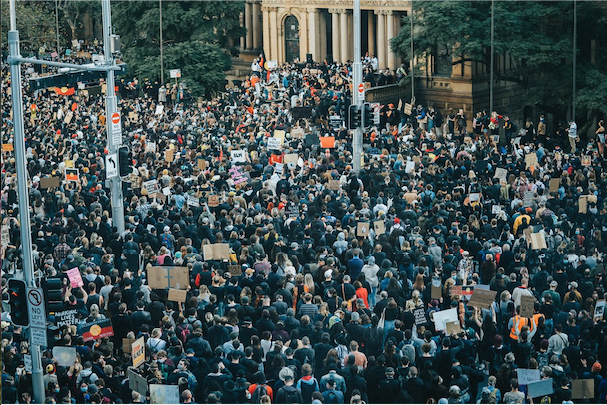Public Memory: The role and curation of commemorative monuments and public art
Image: Luke Currie-Richardson. Photo by Jamie Morris.
Image: Luke Currie-Richardson. Photo by Jamie Morris.

Public Art
art for the public
‘general public’?
people, generally
who people
people…humans?....hu-mons
Monument….monumental
men, tall
for who?
for what?
Monument (noun) - “a statue, building, or other structure erected to commemorate a notable person or event”
Monumental (adjective) - “great in importance, extent, or size”
Statue (noun) - “a carved or cast figure of a person or animal, especially one that is life-size or larger”
Commemorate (verb) - “mark or celebrate (an event or person) by doing or producing something”
*Definitions from Oxford English Dictionary
Growing up - still growing up - on Bidjigal, Gadigal, Ngunnawal, Ngambri, and now Wangal Country. Towering stone, marble, bronze, and concrete figures coercively placed in every city and every town. School excursions throughout primary and secondary education involving activities that include searching for Captain Cook memorabilia or walking tours of The Rocks dressed in colonial and convict attire. What kinds of critical thinkers is our country creating if this is the foundation for learning about colonialism in this country? Or more importantly, what kind of intergenerational trauma are these ‘learning programs’ enabling and re-living for everyone who isn’t white?
Usually placed in areas of high population, significant parks or town squares where people frequently walk past, these figures become the norm, validating their actions as something worthy of celebrating. As Tyler Stiem argues,
“Our relationship to a statue, or a building, or a sign is always changing. Often the change is so gradual, happening over decades and generations, that the monument – the version of reality it embodies – simply recedes into the background…. We make the assumption that the past is past, that those ideas and values no longer have the power to threaten or harm, or never did.”
The deep psychological and physical aggression behind the commissioning and curating of public colonial monuments, representing and reinforcing false histories and trauma, is something that can no longer be ignored. Globally over the past month we have seen a long overdue response to this in a multitude of ways and varying perspectives.
The vast majority of statues, monuments, plaques and white place names in Australia are a testament to perjury and pain. Monuments that celebrate the fostered culture of segregation, oppression, genocide, white power, possession and property in Australia and across the world not only exist, but continue to be commissioned by the government. All contributing to the political infrastructure of Australia, reinforcing the web of lies that is the foundation of this country and Australian Law for the past 250 years, terra nullius.
Daniel Browning’s Hiding in Plain Sight. Decolonising Public Memory as part of the publication Sovereign Words (2018), is an essay that cannot be ignored, especially now. Browning addresses Australian public art as monumentalism, founded in Roman and Greek classicism, and therefore an explicit form of self worship contributing to the inflation of national ego. The curatorial decisions of the commemorative monuments, cannot be ignored in the context of the conscious decision of the government to force a colonial narrative into public memory.
Our mob's public art, commissioned or not, will always be our stories, our truth, our resilience, our continuing histories. Public art produced by Aboriginal and Torres Strait Islander artists and storytellers is an unapologetic reminder, interrupting a narrative of Australian history that, until very recently, was one-sided. The commissioning of the ongoing Eora Journey, curated by Hetti Perkins is a big step forward for commissioned First Nations public art in Sydney. Tony Albert’s 2015 artwork, Yininmadyemi (Thou Didst Let Fall) stands tall in Hyde Park, sharing his grandfather’s story and the shared story of numerous unacknowledged First Nations service people.
Our stories on the street, commissioned by philanthropists, developers, government funding or not commissioned at all, extend beyond any preconceived idea of what defines art. In occupying a public space, we disrupt urban spaces, false histories with or without permission. However, as Daniel Browning so eloquently states, “My criticism of the trend towards aesthetic or visual colonisation is not personal - it is juxtaposed against the structural inability of the nations state to negotiate honestly with the First Peoples and confront the brutal past beyond the aesthetic and immaterial.”
The recent defacement of colonial monuments have led me to research the legal consequences for damaging or vandalising Australia’s commemorative places and monuments. The Protection of Australia’s Commemorative Places and Monuments Report (2018) offers the example of NSW under the Heritage Act 1977 - a maximum of $1,100,000 and/or 6 months imprisonment, or for a ‘graffiti’ offence, between $440 - $2,200 or 12 months imprisonment. This year we have seen numerous commemorative monuments defaced and dismantled that have resulted in masses of fines and arrests. Somehow, I find it difficult to believe that the same consequences would be applied to the defacing of the Lawson Dt Bridge mural, 40,000 Years mural, Reko Rennie’s Welcome to Redfern, and certainly wasn’t applied to the mural of the enormous Aboriginal Flag that was on The Block before developers replaced it with 16 storey student housing so insensitively titled the Pemulwuy Project and leaving a mere 62 homes for mob.

Photo by Luke Currie-Richardson.
The past month has been the largest collective demonstration of civil unrest around state violence and police brutality, certainly in my generation's memory. The unifying theme, Black Lives Matter, a network that formed in a formal context in 2013, but an issue that has been publicly voiced for decades. So, why now white fellas? We certainly haven’t seen these numbers at rallies for Aboriginal Deaths in Custody, nor have we seen much addressing First Nations American experience with police brutality and government authority through the Black Lives Matter campaign.
Is it cool to be anti-racist and pro Black Lives Matter? With such public facing platforms available, I have to question how many supporters might have ulterior motives, virtue signalling, whether conscious or unconscious. Why only in this moment did it finally become inappropriate to be silent? Silence today is seen as being complicit. Does the broader general public finally feel a responsibility? Or do white fellas feel safer or more comfortable knowing that other white fellas are also addressing it too after all these decades?
The shock of recent elections in this country and in the US has seen an increase in individuals joining online advocacy, protest groups, donations to Bla(c)k and First Peoples organisations. Of course the issue of colonial violence and police brutality pre-date these individuals currently in power. But surely having a literal white supremacist in The White House and in Australian Parliament probably contributed to the volume of anti-racist activists. How much of the current fascination with anti-racism and pro-Bla(c)k is really just anti-Trump or anti-Scott Morrison?
The only other major contribution I can pin to this change in the majority of the world in the last 6 months has been the bushfires, floods, and COVID-19. People have lost their jobs, their houses, their loved ones, their livelihoods. The Government's response and the crumbling of commodities that are enormous contributors to the economy in Australia and all over the world could also be an argument towards the collective mass of the Bla(c)k Lives Matter campaign. Has the pandemic made people more scared and less trusting of leadership and those in power? The interruption of routine, lockdowns and working from home, with more people engaging with the news and social media throughout the day, and without the distractions of leisurely social activities that might normally contribute to less screen time. Perhaps the physical vulnerability has made some more empathetic and contributed to the shift in perspectives of others' lived experiences?
With this in mind, I can’t help but ask the question…
Would we be seeing this energy and hype for the rallies, the social media campaigns, the defacements of monuments if so much of the world hadn’t been in lockdown the past 6 months?
Nicole Fisher offers a compelling argument around the predictions of the current global protests drawing connections to the fight or flight response. We’ve seen this before from the Plague - if you paid attention pre-COVID, of course - to Beirut’s continuing response and Chile’s response to anti-government and authority, in 2014 to 2015 in Liberia as a response to Ebola quarantine, prison riots in Mexico with the outbreak of Swine Flu in 2009. These examples are obviously not extensive, but offer a taste to a pattern that we have seen with protest.
Finally, is it a coincidence that as lockdown and social distancing restrictions lift, so does the amount of social media activism? You tell me.